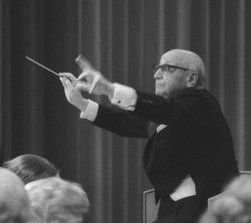Fritz Werner
Fritz Werner was born on 15 December 1898 in Berlin (Germany). His father was a piano maker and so he naturally started to play the piano from early age. He also received lesson with Wolfgang Reimann, the renowned organist of the Jerusalemkirche. After finishing school Fritz Werner studied school and church music in Berlin and became music teacher at a school in Potsdam in 1922. Due to health issues Fritz Werner had to end his career as a school teacher in 1931 and therefore had to work as organist, chorus master, composer and private teacher. In the same year he was accepted for the master class in composition of Georg Schumann at the Preußische Akademie der Künste. He completed his studies in 1935 and graduated with the cantata „An die Toten“ op.8 for which he received the Mendelssohn Award.
In 1939 Fritz Werner was drafted for military service, first in Poland, later at the Siegfried Line. He was taken into American war captivity in 1944 and first became prisoner of war in Camp Concordia in Kansas (USA), later he was transfered to a prisoner-of-war camp in Heilbronn (Germany). He did not return to Potsdam after his release, but applied for the position of the cantor at the Kilianskirche in Heilbronn and was accepted. From that moment to his retirement in 1963 and beyond Fritz Werner dedicated his life and work to rebuild the musical life in Heilbronn. He founded the Heinrich-Schütz-Chorus - a renowned chorus that made recordings for Erato – and the Heilbronner Kirchenmusiktage, a festival of church music. For his dedication Fritz Werner was appointed professor in 1954 and later awarded the German Federal Cross of Merit and the French Chevalier de l'Ordre des Arts et des Lettres.
Fritz Werner died on 23 December 1977 in Heilbronn (Germany)
Fritz Werner composed orchestral, chamber and vocal music with an emphasis on organ and choral works. Among his concertante compositions are concertos for piano, horn, trumpet and violin. The "Concerto for violin and chamber orchestra" op.47 was composed in 1968. The work is still unperformed. The autograph manuscript is archived at the Stadtarchiv Heilbronn.


© pictures with kind permission from the "Fotosammlung Stadtarchiv Heilbronn", photos taken by: O. Schäffler